sEMG and Vibration System Monitoring for Differential Diagnosis in Temporomandibular Joint Disorders
Abstract
1. Introduction
Temporomandibular Disorder Diagnostics
2. Materials and Methods
- Three-click taps used to synchronize signals;
- Slow opening (SO)—three times;
- Fast opening (FO)—three times in each direction;
- Fast adduction (FA)—three times;
- Opening with protruding (OP) the mandible and returning to the rest position;
- Slow protruding (SP)—three times;
- Translation to the right (TR)—slow movements from side to side;
- Translation to the left (TL)—slow movements from side to side;
- Clenching without pads (CWP)—5 s of contraction and 10 s of rest;
- Clenching with pads (CP)—5 s of contraction and 10 s of rest;
- Stopping in the rest position and choking (CH)—three times in each direction;
- Slow coordination tongue exercises (TE)—three times.
2.1. Patient in the Rehabilitation Process
2.2. Acquisition System
2.3. Parameterization
2.4. State Recognition
3. Results
3.1. Rehabilitation Progress
- Periods 1 and 2: the muscle worked at the same level of activity during the exercise but a lower maximum value was obtained during tooth clenching (as a result of muscle relaxation due to regular splint therapy and physiotherapy).
- Periods 2 and 3: there was an increase in muscle activity during maximum contraction (higher maximum value) thus a relative decrease in muscle involvement in the exercise. The reason may have been the lack of availability of physiotherapy and limitations related to splint therapy during the COVID-19 pandemic.
3.2. k-NN Recognition
4. Discussion
Limitations
Author Contributions
Funding
Institutional Review Board Statement
Informed Consent Statement
Data Availability Statement
Conflicts of Interest
References
- Łyżwa, P.; Kłaczyński, M.; Kazana, P. Vibroacoustic methods of imaging in selected temporomandibular disorders during movement. Diagnostyka 2018, 19, 109–117. [Google Scholar] [CrossRef]
- Małgorzata, P.; Małgorzata, K.-M.; Karolina, C.; Gala, A. Diagnostic of Temporomandibular Disorders and Other Facial Pain Conditions—Narrative Review and Personal Experience. Medicina 2020, 56, 472. [Google Scholar] [CrossRef] [PubMed]
- Ismail, F.; Eisenburger, M.; Lange, K.; Schneller, T.; Schwabe, L.; Strempel, J.; Stiesch, M. Identification of psychological comorbidity in TMD-patients. Cranio 2016, 34, 182–187. [Google Scholar] [CrossRef] [PubMed]
- Chang, C.-L.; Wang, D.-H.; Yang, M.-C.; Hsu, W.-E.; Hsu, M.-L. Functional disorders of the temporomandibular joints: Internal derangement of the temporomandibular joint. Kaohsiung J. Med. Sci. 2018, 34, 223–230. [Google Scholar] [CrossRef] [PubMed]
- Carlsson, G.E. Chapter 13: Temporomandibular Joint Disorders. In Functional Occlusion in Restorative Dentistry and Prosthodontics; Mosby Ltd.: Maryland Heights, MO, USA, 2016; pp. 161–171. [Google Scholar]
- Michalek-Zrabkowska, M.; Wieckiewicz, M.; Macek, P.; Gac, P.; Smardz, J.; Wojakowska, A.; Poreba, R.; Mazur, G.; Martynowicz, H. The Relationship between Simple Snoring and Sleep Bruxism: A Polysomnographic Study. Int. J. Environ. Res. Public Health 2020, 17, 8960. [Google Scholar] [CrossRef]
- American Academy of Sleep Medicine. International Classification of Sleep Disorders, 3rd ed.; American Academy of Sleep Medicine: Darien, IL, USA, 2014. [Google Scholar]
- Lobbezoo, F.; Ahlberg, J.; Raphael, K.G.; Wetselaar, P.; Glaros, A.G.; Kato, T.; Santiago, V.; Winocur, E.; de Laat, A.; de Leeuw, R.; et al. International consensus on the assessment of bruxism: Report of a work in progress. J. Oral Rehabil. 2018, 45, 837–844. [Google Scholar] [CrossRef] [PubMed]
- Wieckiewicz, M.; Bogunia-Kubik, K.; Mazur, G.; Danel, D.; Smardz, J.; Wojakowska, A.; Poreba, R.; Dratwa, M.; Chaszczewska-Markowska, M.; Winocur, E.; et al. Genetic basis of sleep bruxism and sleep apnea—Response to a medical puzzle. Sci. Rep. 2020, 10, 7497. [Google Scholar] [CrossRef]
- Beddis, H.; Pemberton, M.; Davies, S. Sleep bruxism: An overview for clinicians. Br. Dent. J. 2018, 225, 497–501. [Google Scholar] [CrossRef]
- Manfredini, D.; Guarda-Nardini, L. Ultrasonography of the temporomandibular joint: A literature review. Int. J. Oral Maxillofac. Surg. 2009, 38, 1229–1236. [Google Scholar] [CrossRef]
- Kurpiel, P.; Kostrzewa-Janicka, J. Dysfunkcja układu ruchowego narządu żucia—Etiologia i klasyfikacja schorzeń (Temporomandibular dysfunction—Etiology and classification of disorders). Przegląd Piśmiennictwa Nowa Stomatol. 2014, 2, 95–99. (In Polish) [Google Scholar]
- Sharma, S.; Pal, U.S.; Gupta, D.S.; Jurel, S.K. Etiological factors of temporomandibular joint disorders. Natl. J. Maxillofac. Surg. 2011, 2, 116–119. [Google Scholar] [CrossRef] [PubMed]
- Czerwińska-Niezabitowska, B.; Kulesa-Mrowiecka, M. Diagnostyka i Leczenie Dysfunkcji Czaszkowo-Żuchwowych w Ujęciu Holistycznym (Diagnostics and Treatment of Cranio-Mandibular Dysfunctions in Holistic Approach), 1st ed.; Medycyna Praktyczna: Kraków, Poland, 2016. (In Polish) [Google Scholar]
- Larheim, T.A.; Hol, C.; Ottersen, M.K.; Mork-Knutsen, B.B.; Arvidsson, L.Z. The Role of Imaging in the Diagnosis of Temporomandibular Joint Pathology. Oral Maxillofac. Surg. Clin. N. Am. 2018, 30, 239–249. [Google Scholar] [CrossRef] [PubMed]
- Gay, T.; Bertolami, C. The Acoustical Characteristics of the Normal and Abnormal Temporomandibular Joint. J. Oral Maxillofac. Surg. 1987, 45, 397–407. [Google Scholar] [CrossRef]
- Wabeke, K.B.; Spruijt, R.J.; van der Weyden, K.J.; Naeije, M. Evaluation of a technique for recording temporomandibular joint sounds. J. Prosthet. Dent. 1992, 68, 676–682. [Google Scholar] [CrossRef]
- Gallo, L.; Airoldi, R.L.; Ernst, B.; Palla, S. Power Spectral Analysis of Temporomandibular Joint Sounds in Asymptomatic Subjects. J. Dent. Res. 1993, 72, 871–875. [Google Scholar] [CrossRef]
- Widmalm, S.; Williams, W.; Adams, B. The wave forms of temporomandibular joint sound clicking and crepitation. J. Oral Rehabil. 1996, 23, 44–49. [Google Scholar] [CrossRef] [PubMed]
- Garcia, A.R.; Madeira, M.C.; Paiva, G.; Olivieri, K.A.N. Joint Vibration Analysis in Patients with Articular Inflammation. Cranio 2000, 18, 272–279. [Google Scholar] [CrossRef] [PubMed]
- Weinberg, L.A.; Lager, L.A. Clinical report on the etiology and diagnosis of TMJ dysfunction-pain syndrome. J. Prosthet. Dent. 1980, 44, 642–653. [Google Scholar] [CrossRef]
- Hammer, M.R.; Kanaan, Y. Imaging of the Pediatric Temporomandibular Joint. Oral Maxillofac. Surg. Clin. N. Am. 2018, 30, 25–34. [Google Scholar] [CrossRef]
- Al-Saleh, M.A.; Flores-Mir, C.; Thie, N.M. Electromyography in diagnosing temporomandibular disorders. J. Am. Dent. Assoc. 2012, 143, 351–362. [Google Scholar] [CrossRef]
- Katzberg, R.W.; Conway, W.F.; Ackerman, S.J.; Gonzales, T.S.; Kheyfits, V.; Cronan, M.S. Pilot Study to Show the Feasibility of High-Resolution Sagittal Ultrasound Imaging of the Temporomandibular Joint. J. Oral Maxillofac. Surg. 2017, 75, 1151–1162. [Google Scholar] [CrossRef] [PubMed]
- Ishigaki, S.; Bessette, R.W.; Maruyama, T. Vibration of the temporomandibular joints with normal radiographic imagings: Comparison between asymptomatic volunteers and symptomatic patients. Cranio 1993, 11, 88–94. [Google Scholar] [CrossRef] [PubMed]
- Christensen, L.; Orloff, J. Reproducibility of temporomandibular joint vibrations (electrovibratography). J. Oral Rehabil. 1992, 19, 253–263. [Google Scholar] [CrossRef] [PubMed]
- Sano, T.; Widmalm, S.-E.; Westesson, P.-L.; Takahashi, K.; Yoshida, H.; Michi, K.; Okano, T. Amplitude and frequency spectrum of temporomandibular joint sounds from subjects with and without other signs/symptoms of temporomandibular disorders. J. Oral Rehabil. 1999, 26, 145–150. [Google Scholar] [CrossRef]
- Ishigaki, S.; Bessette, W.R.; Maruyama, T.; Widmalm, S.E. A Clinical Study of Temporomandibular Joint (TMJ) Vibrations in TMJ Dysfunction Patients. Cranio 1993, 11, 7–14. [Google Scholar] [CrossRef]
- Radke, J.; Garcia, R.; Ketcham, R. Wavelet transforms of TM joint vibrations: A feature extraction tool for detecting reducing displaced disks. Cranio 2001, 19, 84–90. [Google Scholar] [CrossRef]
- Sano, T.; Widmalm, S.-E.; Westesson, P.-L.; Yamaga, T.; Yamamoto, M.; Takahashi, K.; Michi, K.-I.; Okano, T. Acoustic characteristics of sounds from temporomandibular joints with and without effusion: An MRI study. J. Oral Rehabil. 2002, 29, 161–166. [Google Scholar] [CrossRef]
- Honda, K.; Natsumi, Y.; Urade, M. Correlation between MRI evidence of degenerative condylar surface changes, induction of articular disc displacement and pathological joint sounds in the temporomandibular joint. Gerodontology 2008, 25, 251–257. [Google Scholar] [CrossRef]
- Kondrat, W.; Sierpińska, T.; Gołębiewska, M. Vibration analysis of temporomandibular joints—BioJVA device description and its clinical application in dental diagnostics—Review of literature. J. Stomatol. 2012, 65, 207–215. [Google Scholar] [CrossRef]
- Mazzetto, M.O.; Hotta, T.H.; Carrasco, T.G.; Mazzetto, R.G. Characteristics of TMD Noise Analyzed by Electrovibratography. Cranio 2008, 26, 222–228. [Google Scholar] [CrossRef]
- Radke, J.C.; Kull, R.S. Distribution of Temporomandibular Joint Vibration Transfer to the Opposite Side. Cranio 2012, 30, 194–200. [Google Scholar] [CrossRef] [PubMed]
- Hwang, I.-T.; Jung, D.-U.; Lee, J.-H.; Kang, D.-W. Evaluation of TMJ sound on the subject with TMJ disorder by Joint Vibration Analysis. J. Adv. Prosthodont. 2009, 1, 26–30. [Google Scholar] [CrossRef][Green Version]
- Garcia, A.R.; Folli, S.; Zuim, P.R.J.; de Sousa, V. Mandible protrusion and decrease of TMJ sounds: An electrovibratographic examination. Braz. Dent. J. 2008, 19, 77–82. [Google Scholar] [CrossRef] [PubMed]
- Santana-Mora, U.; Cudeiro, J.; Bermudez, M.J.M.; Rilo-Pousa, B.; Pinho, J.C.; Otero-Cepeda, J.; Santana-Penin, U. Changes in EMG activity during clenching in chronic pain patients with unilateral temporomandibular disorders. J. Electromyogr. Kinesiol. 2009, 19, e543–e549. [Google Scholar] [CrossRef] [PubMed]
- Spolaor, F.; Sawacha, Z.; Cocilovo, F.; Cobelli, C.; Gracco, A. Application of surface EMG in young children affected by temporomandibular disorders: A pilot study. Gait Posture 2015, 42, S66. [Google Scholar] [CrossRef]
- Khomich, I.; Rubnikovich, S.; Baradzina, I.; Baradzin, D. Algorithm of diagnostic measures in patients with temporomandibular joint disorders and bruxism. Int. J. Oral Maxillofac. Surg. 2017, 46, 359–360. [Google Scholar] [CrossRef]
- Choi, K.-H.; Kwon, O.S.; Jerng, U.M.; Lee, S.M.; Kim, L.-H.; Jung, J. Development of electromyographic indicators for the diagnosis of temporomandibular disorders: A protocol for an assessor-blinded cross-sectional study. Integr. Med. Res. 2017, 6, 97–104. [Google Scholar] [CrossRef]
- Ferrario, V.F.; Sforza, C. Coordinated electromyographic activity of the human masseter and temporalis anterior muscles during mastication. Eur. J. Oral Sci. 1996, 104, 511–517. [Google Scholar] [CrossRef]
- Schiffman, E.; Ohrbach, R.; Truelove, E.; Look, J.; Anderson, G.; Goulet, J.-P.; List, T.; Svensson, P.; Gonzalez, Y.; Lobbezoo, F.; et al. Diagnostic Criteria for Temporomandibular Disorders (DC/TMD) for Clinical and Research Applications: Recommendations of the International RDC/TMD Consortium Network and Orofacial Pain Special Interest Group. J. Oral Facial Pain Headache 2014, 28, 6–27. [Google Scholar] [CrossRef]
- SENIAM. Surface ElectroMyoGraphy for the Non-Invasive Assessment of Muscles; Project SENIAM; SENIAM Group: Enschede, The Netherlands, 2019. [Google Scholar]
- Barański, R.; Grzeczka, A. Simply And Low Coast Electromyography Signal Amplifier. Diagnostyka 2017, 18, 69–77. [Google Scholar]
- Wieczorek, A.; Loster, J.E. Activity of the masticatory muscles and occlusal contacts in young adults with and without orthodontic treatment. BMC Oral Health 2015, 15, 116. [Google Scholar] [CrossRef] [PubMed]
- Kłaczyński, M.; Wszołek, T. Artificial Intelligence and Learning Systems Methods in Supporting Long-Term Acoustic Climate Monitoring. Acta Phys. Pol. A 2013, 123, 1024–1028. [Google Scholar] [CrossRef]
- Konior, M.; Kłaczyński, M.; Wszołek, W. Reduction of Speech Signal Deformation in Patients after Nasal Septum Surgery (Septolplasty). Acta Phys. Pol. A 2011, 119, 1000–1004. [Google Scholar] [CrossRef]
- Nazmi, N.; Rahman, M.A.A.; Yamamoto, S.-I.; Ahmad, S.A.; Zamzuri, H.; Mazlan, S.A. A Review of Classification Techniques of EMG Signals during Isotonic and Isometric Contractions. Sensors 2016, 16, 1304. [Google Scholar] [CrossRef] [PubMed]
- Barański, R.; Grzeczka, A. Problems in estimation of hand grip force based on EMG signal. Diagnostyka 2015, 16, 21–26. [Google Scholar]
- Shair, E.F.; Ahmad, S.A.; Marhaban, M.H.; Tamrin, S.B.M.; Abdullah, A.R. EMG Processing Based Measures of Fatigue Assessment during Manual Lifting. BioMed Res. Int. 2017, 2017, 3937254. [Google Scholar] [CrossRef]
- Zagrodny, B.; Wojnicz, W.; Ludwicki, M.; Awrejcewicz, J. Could Thermal Imaging Supplement Surface Electromyography Measurements for Skeletal Muscles? IEEE Trans. Instrum. Meas. 2020, 70, 4001310. [Google Scholar] [CrossRef]
- Barański, R. Stability of the EMG Signal Level Within a Six-Day Measuring Cycle. Adv. Intell. Syst. Comput. 2018, 831, 125–137. [Google Scholar] [CrossRef]
- Sabri, M.I.; Miskon, M.F.; Yaacob, M.R.; Basri, A.S.H.; Soo, Y.; Bukhari, W.M. MVC based normalization to improve the consistency of EMG signal. J. Theor. Appl. Inf. Technol. 2014, 65, 336–343. [Google Scholar]
- Marsland, S. Machine Learning—An Algorithmic Perspective; CRC Press, Chapman & Hall Book: Palmerston North, New Zealand, 2015. [Google Scholar]
- Wieckiewicz, M.; Ziętek, M.; Nowakowska, D.; Więckiewicz, W. Comparison of Selected Kinematic Facebows Applied to Mandibular Tracing. BioMed Res. Int. 2014, 2014, 818694. [Google Scholar] [CrossRef]
- Walczyńska-Dragon, K.; Baron, S.; Nitecka-Buchta, A.; Tkacz, E. Correlation between TMD and Cervical Spine Pain and Mobility: Is the Whole Body Balance TMJ Related? BioMed Res. Int. 2014, 2014, 582414. [Google Scholar] [CrossRef]
- Barański, R.; Kozupa, A. Hand Grip-EMG Muscle Response. Acta Phys. Pol. A 2014, 125, A-7–A-10. [Google Scholar] [CrossRef]
- Nascimento, L.L.D.; Amorim, C.F.; Giannasi, L.C.; Oliveira, C.S.; Nacif, S.R.; Silva, A.D.M.; Nascimento, D.F.F.; Marchini, L.; de Oliveira, L.V.F. Occlusal splint for sleep bruxism: An electromyographic associated to Helkimo Index evaluation. Sleep Breath. 2007, 12, 275–280. [Google Scholar] [CrossRef] [PubMed]
- Dalewski, B.; Chruściel-Nogalska, M.; Frączak, B. Occlusal splint versus modified nociceptive trigeminal inhibition splint in bruxism therapy: A randomized, controlled trial using surface electromyography. Aust. Dent. J. 2015, 60, 445–454. [Google Scholar] [CrossRef] [PubMed][Green Version]
- Suvinen, T.I.; Kemppainen, P. Review of clinical EMG studies related to muscle and occlusal factors in healthy and TMD subjects. J. Oral Rehabil. 2007, 34, 631–644. [Google Scholar] [CrossRef] [PubMed]
- Klasser, G.D.; Okeson, J.P. The clinical usefulness of surface electromyography in the diagnosis and treatment of temporomandibular disorders. J. Am. Dent. Assoc. 2006, 137, 763–771. [Google Scholar] [CrossRef] [PubMed]
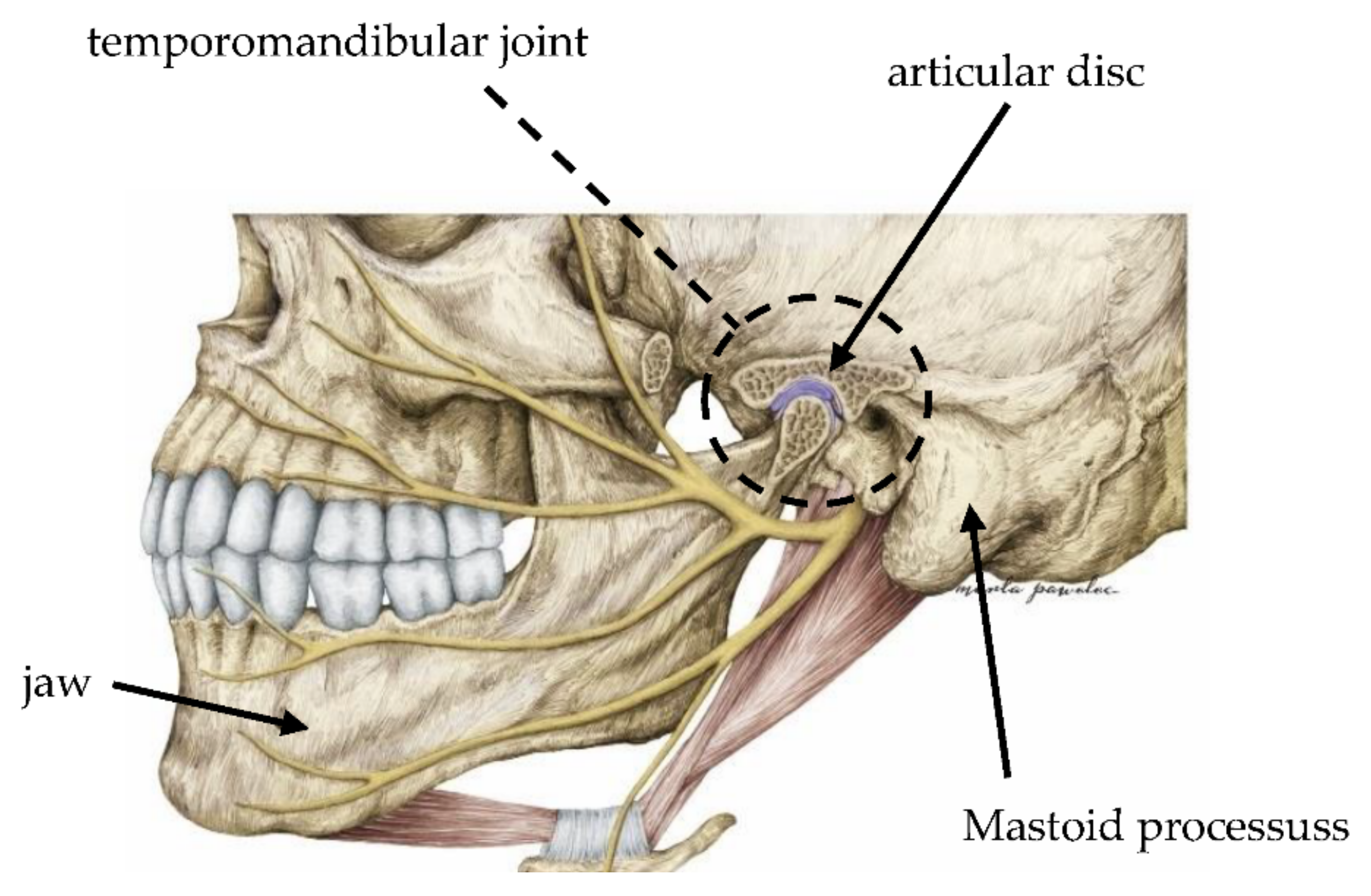
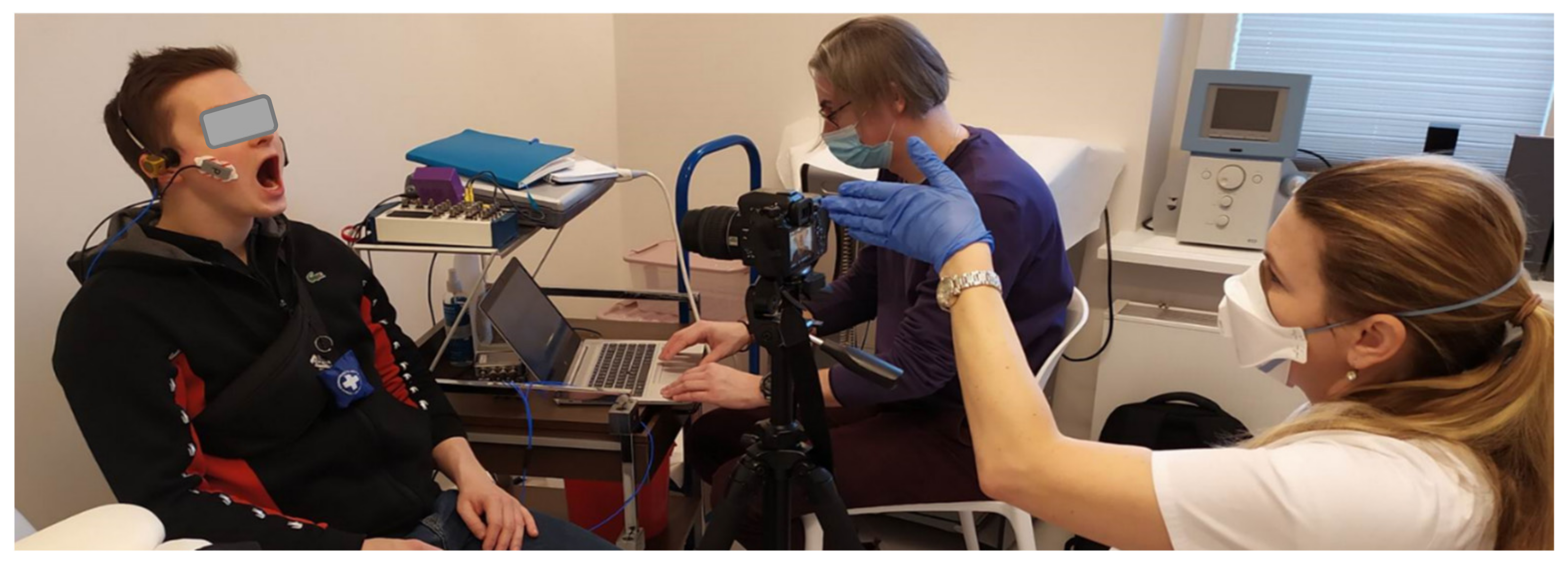
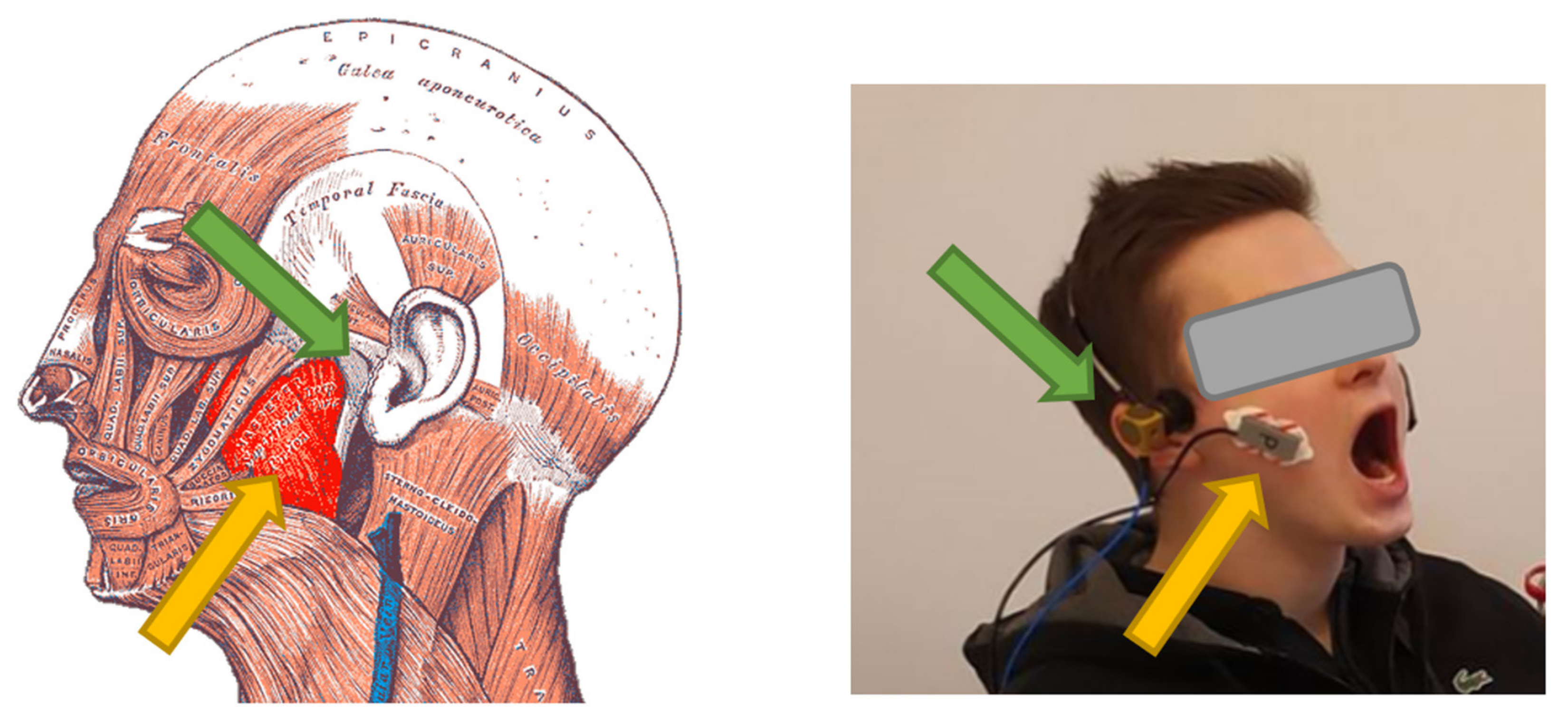

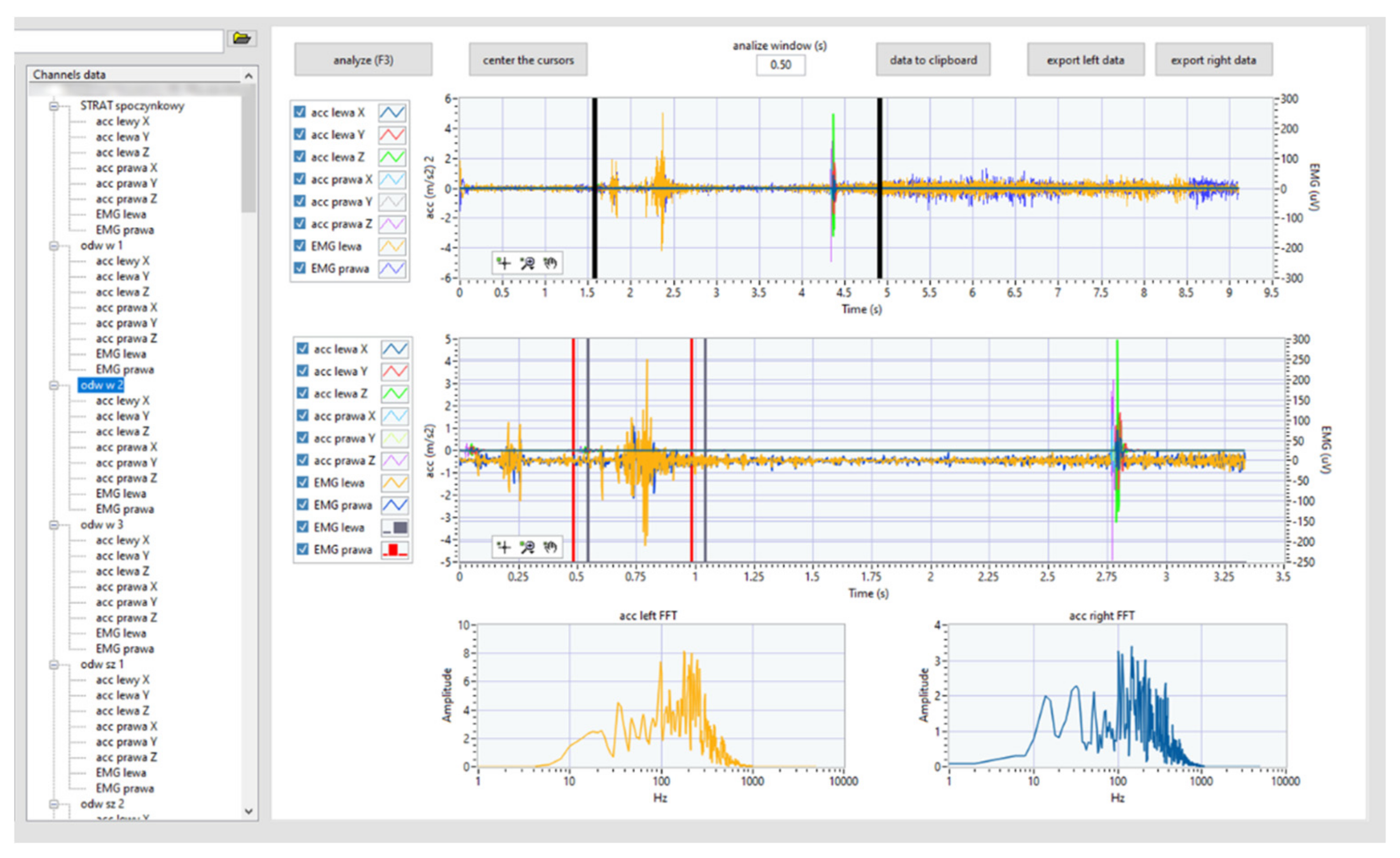
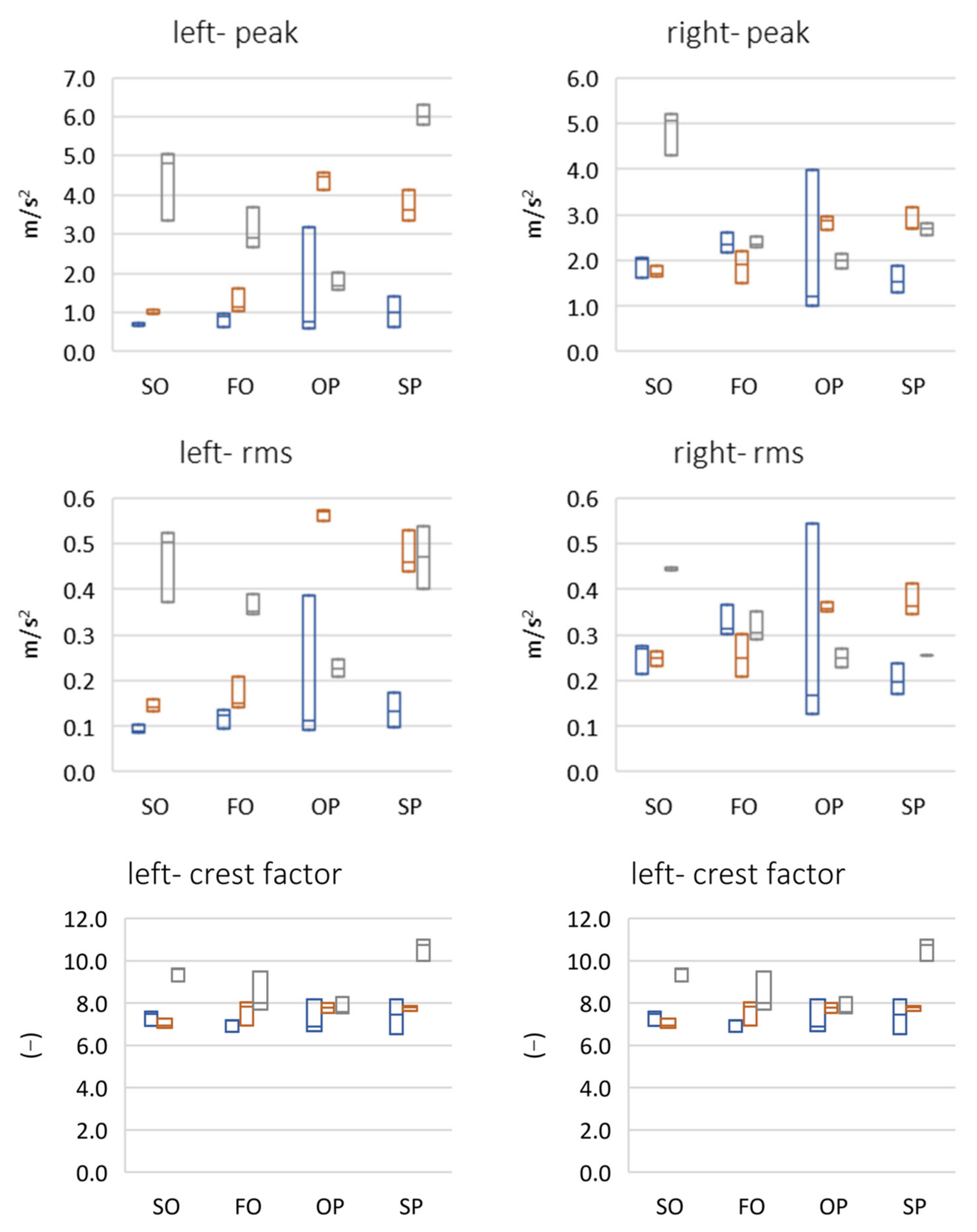
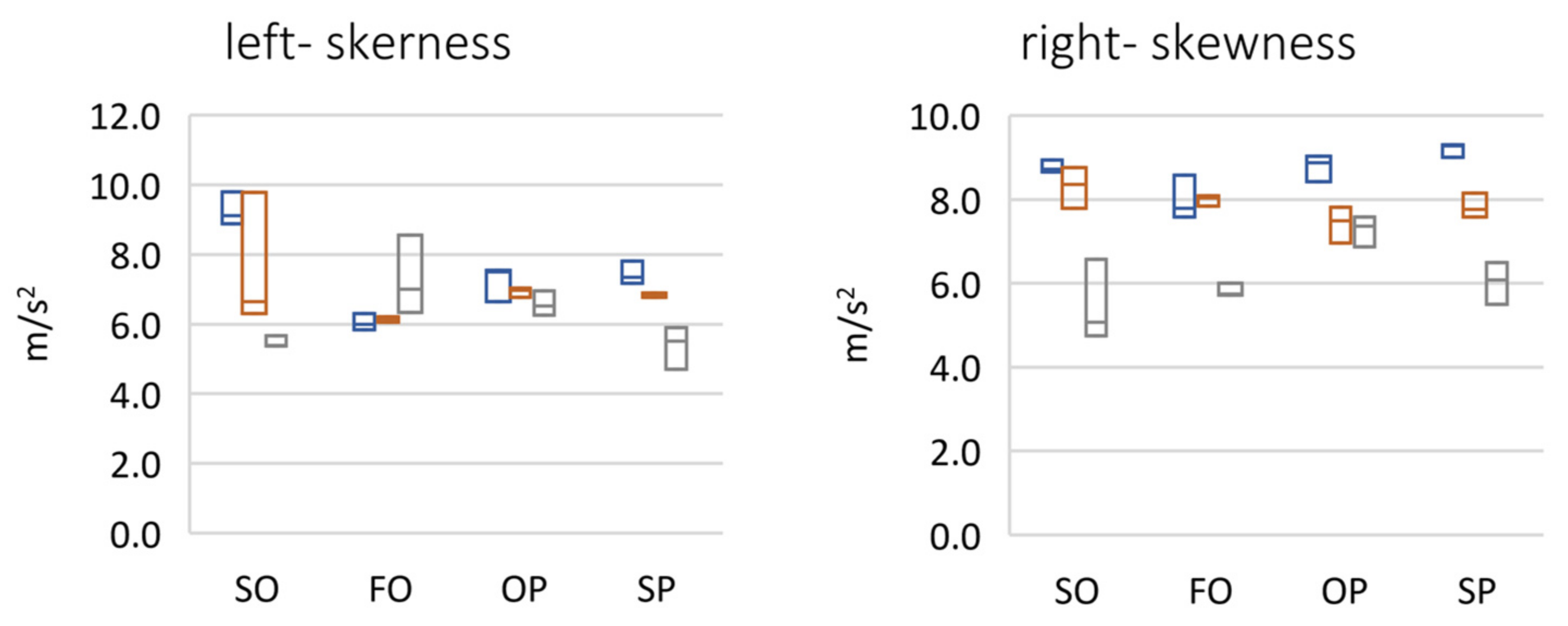
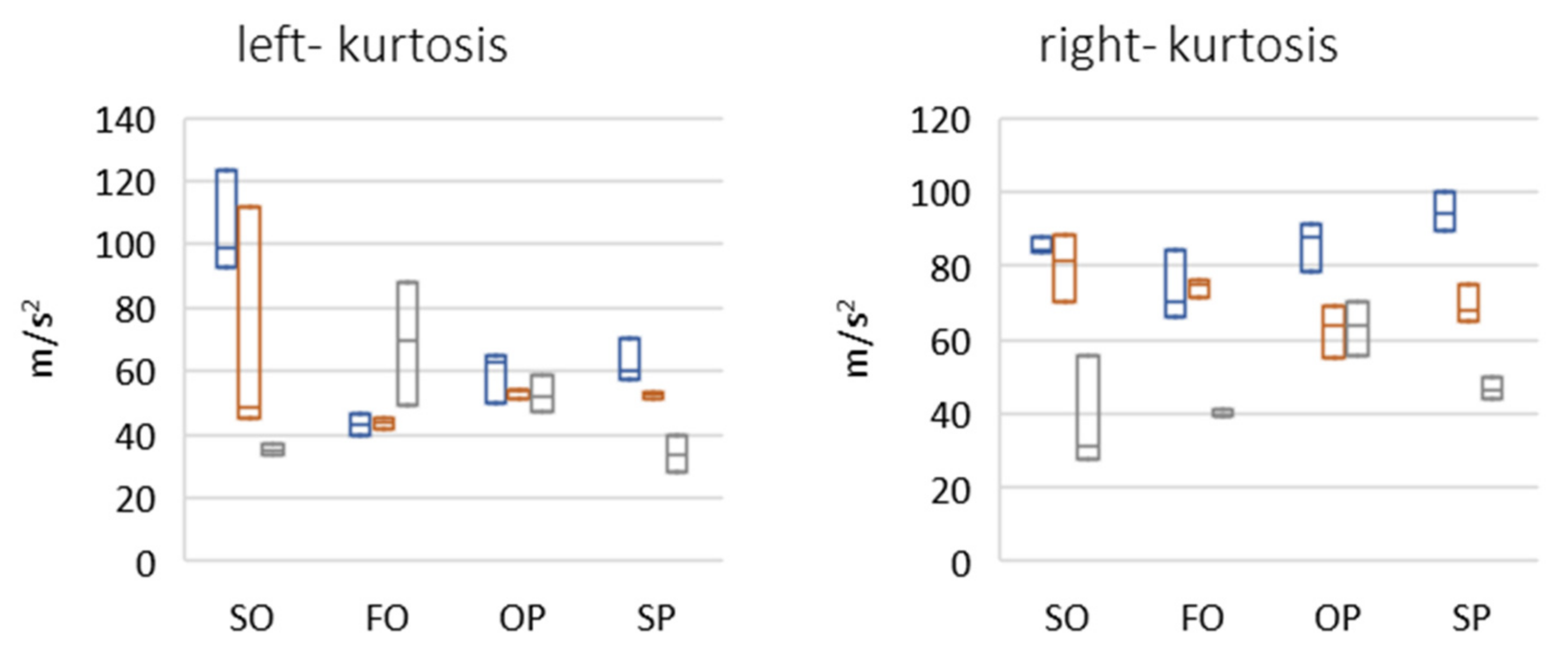
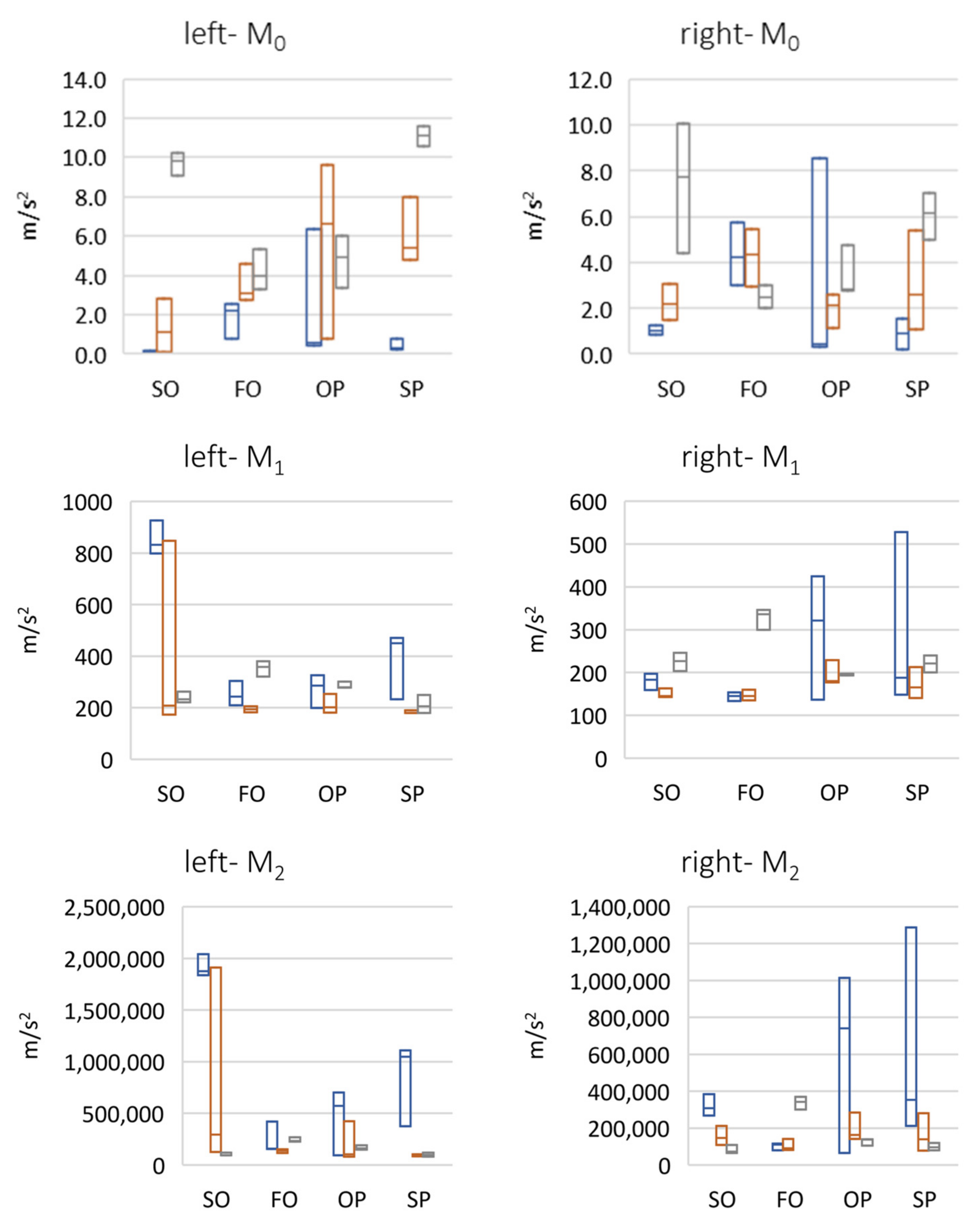
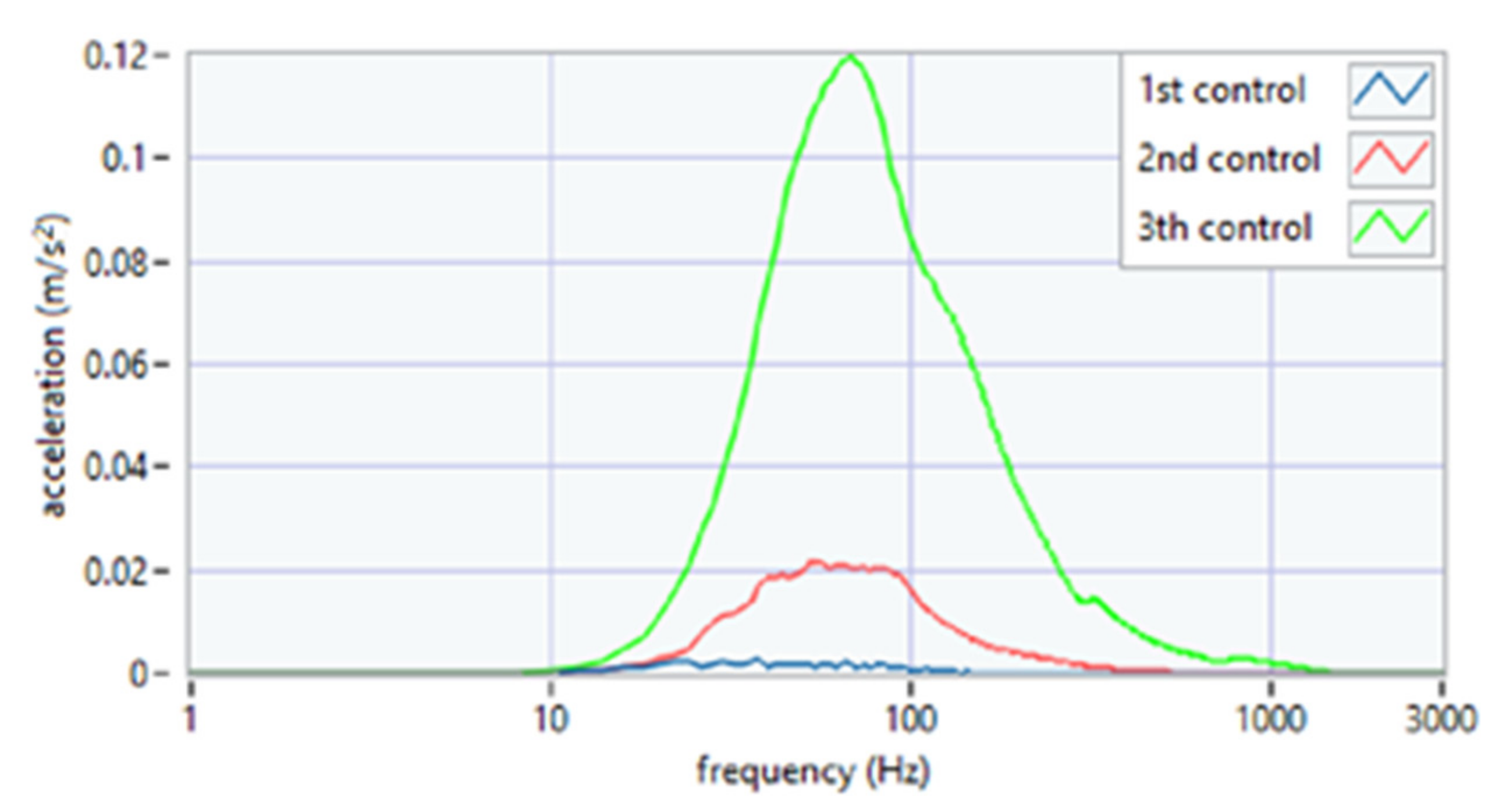
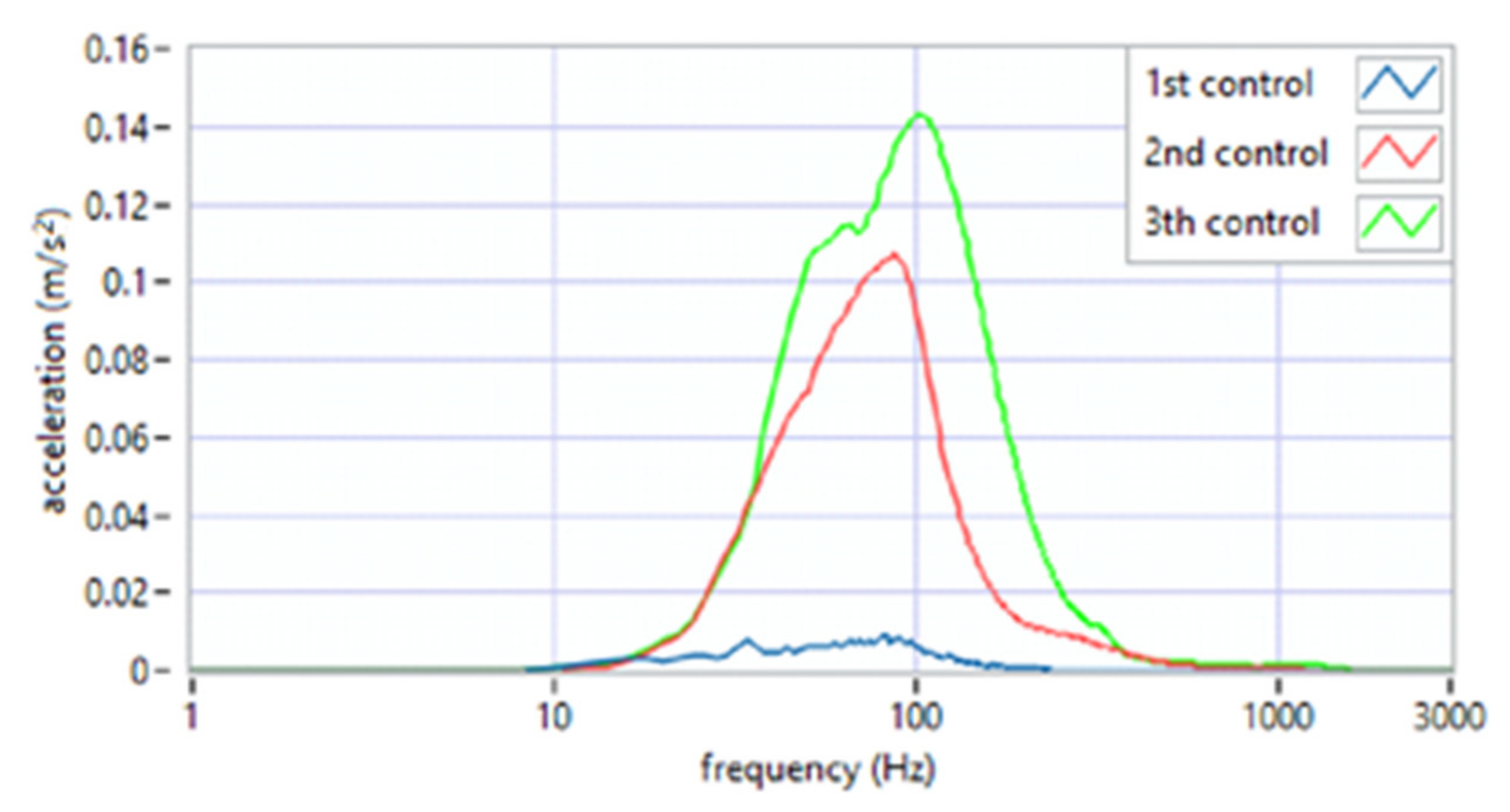
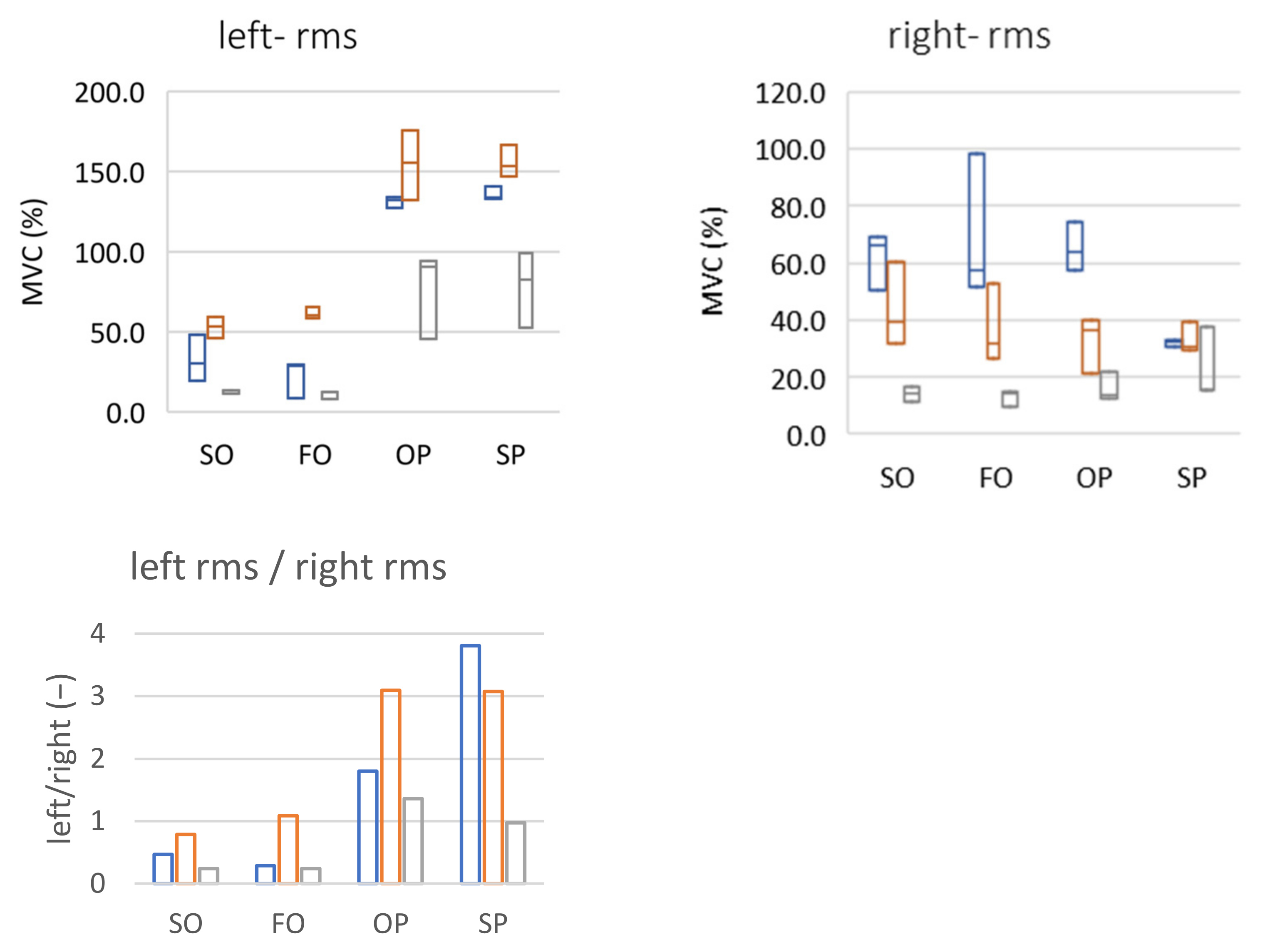


| Left Side | Right Side | ||||
|---|---|---|---|---|---|
| Period | |||||
| 1–2 | 1–3 | 1–2 | 1–3 | ||
| VIB | MAX | R | R | A | R |
| RMS | R | R | A | A | |
| CF | A | R | A | R | |
| M0 | R | R | A | A | |
| M1 | R | A | A | A | |
| M2 | R | A | A | A | |
| SKEWNESS | A | A | A | R | |
| KUROSIS | A | A | A | R | |
| EMG | MVC_RMS | R | A | A | A |
| EX | NUM | REC | PEAK | RMS | CREST | M0 | M1 | M2 | Skewness | Kurtosis | |
|---|---|---|---|---|---|---|---|---|---|---|---|
| V1L | SO | 2 | uh | 7.3 | 1.2 | 5.9 | 7.1 | 637 | 1,176,830 | 5.8 | 39.4 |
| V1R | SO | 2 | uh | 13.8 | 2.3 | 6.1 | 5.0 | 211 | 102,890 | 6.1 | 46.2 |
| V1L | FO | 2 | uh | 8.8 | 1.0 | 8.5 | 3.5 | 302 | 211,548 | 5.2 | 33.9 |
| V1R | FO | 2 | uh | 1.8 | 0.3 | 5.8 | 1.7 | 321 | 345,269 | 5.9 | 40.8 |
| V1L | OP | 2 | uh | 0.1 | 0.02 | 4.5 | 0.1 | 574 | 1,295,310 | 8.3 | 74.4 |
| V1R | OP | 2 | uh | 3.2 | 0.3 | 11.6 | 1.5 | 463 | 442,047 | 3.7 | 19.2 |
| V1L | SP | 2 | uh | 0.03 | 0.01 | 3.1 | 0.06 | 807 | 1,670,840 | 11.3 | 164.4 |
| V1R | SP | 2 | uh | 0.05 | 0.01 | 3.6 | 0.04 | 995 | 214,817 | 8.9 | 89.8 |
| V11L | SO | 3 | h | 0.07 | 0.01 | 6.8 | 0.04 | 1329 | 2,495,700 | 10.9 | 144.7 |
| V11R | SO | 3 | h | 0.04 | 0.01 | 2.9 | 0.04 | 1374.3 | 2,525,430 | 8.4 | 82.0 |
| V11L | FO | 3 | h | 0.03 | 0.1 | 2.8 | 0.03 | 1362.9 | 2.51 × 106 | 13.5 | 218.4 |
| V11R | FO | 3 | h | 0.16 | 0.03 | 4.7 | 0.24 | 453.7 | 743,576 | 6.14 | 49.6 |
| V11L | OP | 3 | h | 0.06 | 0.01 | 3.8 | 0.04 | 869.4 | 1.96 × 106 | 10.2 | 116.7 |
| V11R | OP | 3 | h | 0.1 | 0.02 | 4.7 | 0.2 | 424.3 | 1.0 × 106 | 9.8 | 111.8 |
| V11L | SP | 3 | h | 0.02 | 0.01 | 2.0 | 0.02 | 1353.8 | 2.5 × 106 | 12.7 | 190.1 |
| V11R | SP | 3 | h | 0.03 | 0.01 | 2.6 | 0.05 | 972.9 | 2.07 × 106 | 11.1 | 141.7 |
| EX | NUM | REC | MVC | |
|---|---|---|---|---|
| E1L | SO | 2 | uh | 11.51 |
| E1R | SO | 2 | uh | 2.90 |
| E1L | FO | 2 | uh | 12.60 |
| E1R | FO | 2 | uh | 3.31 |
| E1L | OP | 2 | uh | 43.69 |
| E1R | OP | 2 | uh | 11.28 |
| E1L | SP | 2 | uh | 40.68 |
| E1R | SP | 2 | uh | 9.75 |
| E11L | SO | 3 | h | 12.71 |
| E11R | SO | 3 | h | 7.67 |
| E11L | FO | 3 | h | 12.38 |
| E11R | FO | 3 | h | 7.50 |
| E11L | OP | 3 | h | 26.03 |
| E11R | OP | 3 | h | 10.32 |
| E11L | SP | 3 | h | 24.44 |
| E11R | SP | 3 | h | 6.63 |
| Effectiveness of Classification [%] | |||||||
|---|---|---|---|---|---|---|---|
| Slow Opening (SO) | Fast Opening (FO) | Opening with Protruding (OP) | Slow Protruding (SP) | ||||
| VIB | EMG | VIB | EMG | VIB | EMG | VIB | EMG |
| 76.6 | 62.5 | 82.1 | 68.7 | 71.1 | 75.0 | 73.6 | 62.5 |
| VIB + EMG | VIB + EMG | VIB + EMG | VIB + EMG | ||||
| 62.1 | 85.3 | 79.1 | 56.3 | ||||
| Effectiveness of Classification [%] | |||
|---|---|---|---|
| Slow Opening (SO) + Slow Protruding (SP) | Fast Opening (FO) + Opening with Protruding (OP) | ||
| VIB | EMG | VIB | EMG |
| 79.8 | 54.7 | 84.3 | 63.3 |
| VIB + EMG | VIB + EMG | ||
| 63.6 | 85.9 | ||
Publisher’s Note: MDPI stays neutral with regard to jurisdictional claims in published maps and institutional affiliations. |
© 2022 by the authors. Licensee MDPI, Basel, Switzerland. This article is an open access article distributed under the terms and conditions of the Creative Commons Attribution (CC BY) license (https://creativecommons.org/licenses/by/4.0/).
Share and Cite
Kulesa-Mrowiecka, M.; Barański, R.; Kłaczyński, M. sEMG and Vibration System Monitoring for Differential Diagnosis in Temporomandibular Joint Disorders. Sensors 2022, 22, 3811. https://doi.org/10.3390/s22103811
Kulesa-Mrowiecka M, Barański R, Kłaczyński M. sEMG and Vibration System Monitoring for Differential Diagnosis in Temporomandibular Joint Disorders. Sensors. 2022; 22(10):3811. https://doi.org/10.3390/s22103811
Chicago/Turabian StyleKulesa-Mrowiecka, Małgorzata, Robert Barański, and Maciej Kłaczyński. 2022. "sEMG and Vibration System Monitoring for Differential Diagnosis in Temporomandibular Joint Disorders" Sensors 22, no. 10: 3811. https://doi.org/10.3390/s22103811
APA StyleKulesa-Mrowiecka, M., Barański, R., & Kłaczyński, M. (2022). sEMG and Vibration System Monitoring for Differential Diagnosis in Temporomandibular Joint Disorders. Sensors, 22(10), 3811. https://doi.org/10.3390/s22103811







